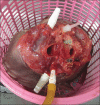Silicone injected cadaveric head for neurosurgical dissection: Prepared from defrosted cadaver
- PMID: 24049551
- PMCID: PMC3775188
- DOI: 10.4103/1793-5482.116382
Silicone injected cadaveric head for neurosurgical dissection: Prepared from defrosted cadaver
Abstract
Background: Most reports of cadaveric specimen preparation for neurosurgical dissection describe methods using fresh cadavers. Our cultural limitations prevent us from obtaining fresh cadaveric heads.
Objective: To study and report on an alternative method of preparation of head specimens for neurosurgical dissection using defrosted cadavers.
Materials and methods: Twenty-four head specimens were procured through the Department of Anatomy, received by donation three to seven days after funeral activity. The specimens were sectioned through the neck, and preserved by refrigeration at a temperature of -10°C for a period of one week to three months prior to preparation. The process began with defrosting the frozen head specimens for 48 hours in a refrigerator, in which the temperature was controlled within the range of -2° to -8°C. The great vessels were identified and cannulated. These were then irrigated with tap water until clear, following which colored silicone was injected. The specimens were preserved in 95% ethyl alcohol, and were assessed for quality one week after the preparation process. They were then re-assessed at monthly intervals for 12 months.
Results: When compared with specimens prepared from fresh cadavers, our method provided similar quality specimens for dissection. The scalp and muscles of all specimens remained soft. The vasculature was good, and the colored silicone made identification easy. The brain tissues were soft and easily retracted, and still in good condition for dissection after a long preparation period (12 months).
Conclusion: The head specimens prepared with this method were of good quality for dissection, and were comparable in quality to those prepared from fresh cadavers as in published methods. We were thus able to provide a suitable substitute to fresh head specimens in situations where access to fresh cadavers is unavailable.
Keywords: Defrosted cadaver; neurosurgical dissection; silicone injected cadaveric head.
Conflict of interest statement
Figures
References
-
- Sanan A, bdel Aziz KM, Janjua RM, van Loveren HR, Keller JT. Colored silicone injection for use in neurosurgical dissections: anatomic technical note. Neurosurgery. 1999;45:1267–71. - PubMed
-
- Mayer R. California: Appleton and Lange; 1990. Theory and Practice: Embalming.
-
- Hayes RB, Blair A, Stewart PA, Herrick RF, Mahar H. Mortality of U.S. embalmers and funeral directors. Am J Ind Med. 1990;18:641–52. - PubMed
LinkOut - more resources
Full Text Sources
Other Literature Sources
Miscellaneous



